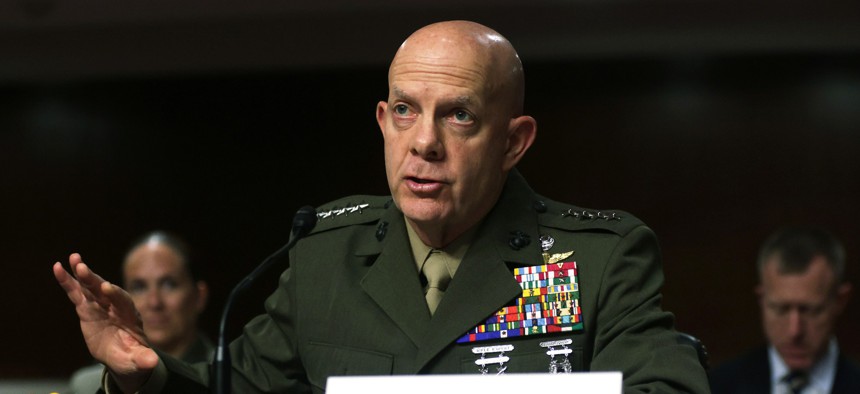
U.S. Marine Corps Gen. David Berger, shown here at a 2021 Senate hearing, signed the Marine Corps Doctrinal Publication on information on June 29. Alex Wong/Getty Images
Fight With Information, Not Just Munitions, Marine Corps Tells Commanders
A new doctrinal document asks Marines to consider information warfare as they build their battle plans.
The Marine Corps wants commanders and service members to start thinking about how information fits into warfighting operations. And it all starts with a new discussion document that aims to illustrate how information, and the systems used to transmit it, are used in conflict.
The 126-page document, called Marine Corps Doctrinal Publication 8, explains concepts like the "information environment" and "prevailing narratives" and how these fit into military objectives.
"By elevating information as a warfighting function, we're making it a prominent consideration for commanders in their planning process from the beginning, so that we don't have a situation where they're developing our plan, and then bringing in our information professionals, like our [information operations] folks, sort of at the tail end to try and resolve that issue," Eric Schaner, the Marine Corps' senior information policy and strategy analyst, told reporters June 28.
The goal is for the concepts laid out in the doctrinal document to eventually make their way to training, be incorporated into wargaming efforts, and help determine what capabilities gaps exist – particularly with respect to command and control systems, officials said. Additionally, the authors want marines to become more familiar with how competitors, in particular Russia and China, view information warfare.
"If we view the information environment as a contested space, we need to be able to sense and understand that space. And so battlespace awareness in the information environment is crucial," Schaner said. "And the Marine Corps is contributing to the joint force, we must close gaps and resolve our command and control architectures and make them as seamless as possible so that we can coordinate action across large distributed areas using joint forces in every domain."
Lt. Gen. Matthew Glavy, deputy commandant for information, told reporters the commandant was intimately involved in the document's editing process, particularly when it came to incorporating examples from ongoing conflict in Ukraine amid Russia's invasion, including the Biden administration's push to "preempt" Russia's pre-invasion narratives with the release of satellite images and other intelligence information, and commentary on Ukraine President Volodymyr Zelensky's "masterful use of digital media and inspirational messaging."
"Those were near-real-time updates, as we were going into final editing, on the document editing, adding and updating, because we thought those lessons were critical," Glavy said.
Said Schaner: "If you take a look at the Ukraine scenario, and you try to look at it through the lens that we provided in MCDP-8 the three types of advantages that we describe—systems overmatch, prevailing narrative and resiliency—you can see those at work and at play in the Ukraine scenario."
For example, Zelenskyy "has been able to maintain communications channels, even thwarting attempts by Russia to deny that form of communication through Starlink terminals"—an example of systems overmatch, he said.
"So you combine the ability to continue to communicate, to generate support and to inspire your people to stand and fight. You're now building the idea of resiliency within Ukraine. And we see that combined with some of the problems that Russia has had and we're seeing a persistent, and resilient Ukraine stand and fight," Schaner said.




